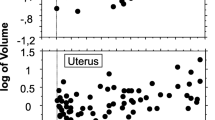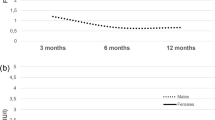Abstract
Background
Hormonally sensitive organs in the neonate can change size within days of birth as circulating maternal estrogen wanes. Although several reports document the size of these organs through infancy, few focus attention on the near-birth period. Clinical and research evaluation of hormonal and genitourinary disorders would benefit from reference size standards.
Objective
We describe the size of the uterus, ovaries, testes and breast buds in healthy term neonates.
Materials and methods
As part of the Infant Feeding and Early Development (IFED) study, we sonographically measured the largest diameter of these organs in sagittal, transverse and anterior-posterior planes for 194 female and 204 male newborns up to 3 days old. We calculated mean, median and percentiles for longest axis length and for volume calculated from measured diameters. We evaluated size differences by laterality, gender and race and compared our observations against published values.
Results
Mean length and mean volume were as follows: uterus, 4.2 cm and 10.0 cm3; ovary, 1.0 cm and 0.2 cm3; testis, 1.1 cm and 0.3 cm3 (0.4 cm3 Lambert volume); female breast bud, 1.2 cm and 0.7 cm3; male breast bud, 1.1 cm and 0.6 cm3. Breast buds were larger in females than males. Laterality differences were typically below the precision of clinical measurement. No significant race differences were detected.
Conclusion
Using data from our large cohort together with published values, we provide guidelines for evaluating the size of reproductive organs within the first 3 days of age. Discrepancies between our results and published values are likely attributable to technique.





Similar content being viewed by others
References
Khadilkar VV, Khadilkar AV, Kinare AS et al (2006) Ovarian and uterine ultrasonography in healthy girls between birth to 18 years. Indian Pediatr 43:625–630
Keats TE, Sistrom C (2001) Atlas of radiologic measurement, 7th edn. Mosby, St. Louis
Gilchrist JM, Moore MB, Andres A et al (2010) Ultrasonographic patterns of reproductive organs in infants fed soy formula: comparisons to infants fed breast milk and milk formula. J Pediatr 156:215–220
Cassorla FG, Golden SM, Johnsonbaugh RE et al (1981) Testicular volume during early infancy. J Pediatr 99:742–743
Cohen HL, Shapiro MA, Mandel FS et al (1993) Normal ovaries in neonates and infants: a sonographic study of 77 patients 1 day to 24 months old. AJR Am J Roentgenol 160:583–586
Griffin IJ, Cole TJ, Duncan KA et al (1995) Pelvic ultrasound measurements in normal girls. Acta Paediatr 84:536–543
Forest MG, De Peretti E, Bertrand J (1976) Hypothalamic-pituitary-gonadal relationships in man from birth to puberty. Clin Endocrinol 5:551–569
Nguyen RH, Umbach DM, Parad RB et al (2011) US assessment of estrogen-responsive organ growth among healthy term infants: piloting methods for assessing estrogenic activity. Pediatr Radiol 41:633–642
Orbak Z, Kantarci M, Yildirim ZK et al (2007) Ovarian volume and uterine length in neonatal girls. J Pediatr Endocrinol Metab 20:397–403
Haber HP, Mayer EI (1994) Ultrasound evaluation of uterine and ovarian size from birth to puberty. Pediatr Radiol 24:11–13
Bernbaum JC, Umbach DM, Ragan NB et al (2008) Pilot studies of estrogen-related physical findings in infants. Environ Health Perspect 116:416–420
Kuijper EA, van Kooten J, Verbeke JI et al (2008) Ultrasonographically measured testicular volumes in 0- to 6-year-old boys. Hum Reprod 23:792–796
Main KM, Toppari J, Suomi AM et al (2006) Larger testes and higher inhibin B levels in Finnish than in Danish newborn boys. J Clin Endocrinol Metab 91:2732–2737
Francis GL, Hoffman WH, Gala RR et al (1990) A relationship between neonatal breast size and cord blood testosterone level. Ann Clin Lab Sci 20:239–244
McKiernan JF, Hull D (1981) Breast development in the newborn. Arch Dis Child 56:525–529
Nussbaum AR, Sanders RC, Jones MD (1986) Neonatal uterine morphology as seen on real-time US. Radiology 160:641–643
Hata K, Nishigaki A, Makihara K et al (1989) Ultrasonic evaluation of the normal uterus in the neonate. J Perinat Med 17:313–317
Kuiri-Hänninen T, Haanpää M, Turpeinen U et al (2013) Postnatal ovarian activation has effects in estrogen target tissues in infant girls. J Clin Endocrinol Metab 98:4709–4716
Kuiri-Hänninen T, Seuri R, Tyrväinen E et al (2011) Increased activity of the hypothalamic-pituitary-testicular axis in infancy results in increased androgen action in premature boys. J Clin Endocrinol Metab 96:98–105
WHO Multicentre Growth Reference Study Group (2006) WHO child growth standards based on length/height, weight and age. Acta Paediatr Suppl 450:76–85
Lambert B (1951) The frequency of mumps and of mumps orchitis and the consequences for sexuality and fertility. Acta Genet Stat Med 2:1–166
Rivkees SA, Hall DA, Boepple PA et al (1987) Accuracy and reproducibility of clinical measures of testicular volume. J Pediatr 110:914–917
Lin CC, Huang WJ, Chen KK (2009) Measurement of testicular volume in smaller testes: how accurate is the conventional orchidometer? J Androl 30:685–689
Bardo DM, Black M, Schenk K et al (2009) Location of the ovaries in girls from newborn to 18 years of age: reconsidering ovarian shielding. Pediatr Radiol 39:253–259
Acknowledgments
This research was supported in part by the Intramural Research Program of the National Institutes of Health (NIH), National Institute of Environmental Health Sciences (project number Z01-ES044006). Data collection at the Children’s Hospital of Philadelphia (CHOP) was supported through subcontract PHR-SUPS2-S-09-00196 under contract HHSN291200555546C between the National Institute of Environmental Health Sciences and Social & Scientific Systems Inc. This project was supported by the Nutrition Center at the Children’s Hospital of Philadelphia and by the National Center for Research Resources, Grant UL1TR000003. The content is solely the responsibility of the authors and does not necessarily represent the official views of the NIH.
We are grateful to all subjects and families for participation. We thank the care providers and staff at our three main study sites: the University of Pennsylvania Hospital, Pennsylvania Hospital and Virtua Voorhees Hospital; and at our four additional study sites: Virtua Memorial Hospital, Abington Memorial Hospital, Cooper Memorial Hospital and Holy Redeemer Hospital, where all of our birth visits took place. We thank Els Nijs, MD, Adeka McIntosh, MD, Laura Poznick, RDMS, Trudy Morgan, RDMS, Marcy Hutchinson, RDMS, RVT, Danielle Drigo, IFED Team of Research Assistants, and the Department of Radiology at CHOP for their work with study design, quality assurance, data procedures and collection. We thank our collaborators at the Department of Radiology at Virtua Voorhees, Elizabeth Fong-deLeon, MD, Department of Pediatrics at Virtua Voorhees Hospital, and Steven Shapiro, MD, Department of Pediatrics at Abington Memorial Hospital.
Author information
Authors and Affiliations
Corresponding author
Ethics declarations
Conflicts of interest
None
Rights and permissions
About this article
Cite this article
Kaplan, S.L., Edgar, J.C., Ford, E.G. et al. Size of testes, ovaries, uterus and breast buds by ultrasound in healthy full-term neonates ages 0–3 days. Pediatr Radiol 46, 1837–1847 (2016). https://doi.org/10.1007/s00247-016-3681-0
Received:
Revised:
Accepted:
Published:
Issue Date:
DOI: https://doi.org/10.1007/s00247-016-3681-0




